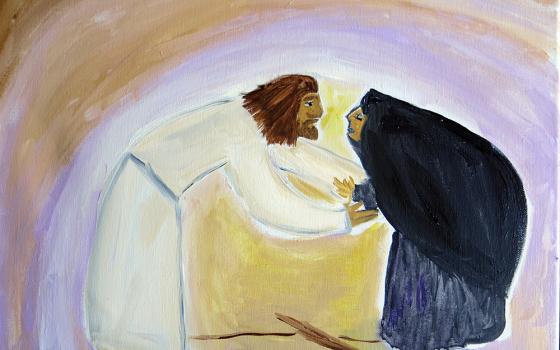Part one of a two-part series.
There is a powerful scene in the Gospels that shows in a flash how life-giving the encounter between Jesus and women can be. As Luke tells the story:
Jesus was teaching in one of the synagogues on the Sabbath, and a woman came in who had been crippled by a spirit for 18 years. She was bent over and could not straighten up at all. When Jesus saw her, he called her forward and said to her, “Woman, you are set free from your infirmity.” Then he put his hands on her, and immediately she stood up straight and began to praise God. (Lk 13:10-13)
Notice the setting: a holy place where the community gathers on the Sabbath day. Notice, too, the position of Jesus: front and center, the famous teacher instructing the group. It is a solemn moment. The woman slips in quietly. She is nobody important. For almost two decades she has moved through the world stooped over, crippled by a terrible handicap, a pitiful figure in the eyes of her neighbors. Unless she makes a great effort, all she sees as she moves through her life is the ground or the floor. Now she just wants to listen and pray.
But Jesus notices. He could have gone on with his teaching, but, as we are told in other stories, a feeling of compassion wells up in his heart. He stops mid-stream, turning full attention her way. In front of the whole assembly he calls her forth, reaches out, and his powerful words and healing touch bring strength to her twisted spine. “Woman, you are set free!”
Imagine how it felt to stand up straight, to lift up her head, to look around and see faces instead of the ground. A new way of life opens before her. And this woman knew whom to thank. She praises God for showing her such tender mercy through the kindness of this prophet and teacher, Jesus of Nazareth.
Christian women today read this story as a revelation of what their relationship with Jesus can bring about. Bent over by many forces, they find his powerful compassion a spur to liberation, enabling them to stand up straight. Women scholars are discovering that there are many scenes like this in the New Testament that show Jesus’ love for women, his concern for their well-being, and his freeing effect on their lives. But over the centuries the power of these stories has often been ignored because the men who preach and teach usually do not appreciate the suffering that women bear. What are some?
Burdens
Society: Consider these U.N. statistics: women, who form half of the world’s population, work three-fourths of the world’s working hours; receive one-tenth of the world’s salary; own one percent of the world’s land; form two-thirds of illiterate adults; and together with their dependent children form three-fourths of the world’s starving people.
To make a bleak picture worse, women are subject to domestic violence at home and are raped, prostituted, trafficked into sexual slavery and murdered by men to a degree that is not reciprocal. Regarding education, employment and other social goods, men have advantages simply by being born male. Racial and ethnic prejudices add further disadvantage to women, as does class privilege that disrespects women who are poor. Every culture has different dynamics. But it is always women who are regarded as of least value.
This situation, called sexism, or prejudice against women because of their sex, is rampant on a global scale. To point this out is not to make women into a class of victims but to underscore statistics that make clear the struggles women face in society because of their gender. In no country on earth are women and men yet treated in an equal manner befitting their human dignity.
In 1995 the United Nations held a conference on women in Beijing, China. An historic event, it was the first gathering attended by women from every nation in the world. On that occasion Pope John Paul II wrote a Letter to Women strongly supporting the conference’s agenda of social equality:
As far as personal rights are concerned, there is an urgent need to achieve real equality in every area: equal pay for equal work, protection for working mothers, fairness in career advancement, equality of spouses with respect to family rights and the recognition of everything that is part of the rights and duties of citizens in a democratic state. This is matter of justice, but also of necessity. (Letter to Women at the Beijing Conference, July 1995, par. 4)
This was a most welcome letter, putting the Catholic Church squarely in league with women’s struggle for justice. The movement to obtain equality for women in law and culture is actually a movement for social justice in accord with Catholic social teaching. This in turn is based on the truth that women, like men, are created in the image and likeness of God, and should live with the dignity befitting all human persons.
However, there are problems in the church itself that the pope did not address.
Church: Christianity took shape in the culture of the Roman Empire where elite men held power over lesser men, women, children and slaves. This social structure, called patriarchy (rule of the father), is a pyramid-shaped arrangement where power is always in the hands of a dominant man or group of men. As the church grew and became established, its leaders adopted this pattern for its own internal life. Within this system, some men may be very respectful of women and even love them. But women are of necessity placed in unequal, predetermined roles. Men teach and decide; women listen and obey.
The church reflects this inequality in all of its aspects. Sacred texts, religious symbols, doctrines, moral teachings, canon laws, rituals and governing offices are all designed and led by men. Even God is imagined most often as a powerful patriarch in heaven ruling the earth and its peoples. In turn, this sacred patriarchy justifies the rule of men over women in family and the wider society.
While the histories are different, a similar pattern afflicts all the world’s religions.
Theology in women’s voices
In view of these burdens, women theologians today are discovering that the power of encounter with Jesus is liberating. His words to the first-century woman echo down through the centuries: “Woman, you are set free.”
The fact that there are women theologians noticing this at all is a startling development. For 2,000 years almost all Christian theology has been done by men. After the Second Vatican Council (1962-1965) opened the study of theology to lay persons in the church, many women began to be educated in this field. The work of theology, as Anselm of Canterbury famously defined it, is “faith seeking understanding.” The goal of this thinking is to shed light on faith’s meaning so it can be lived more vibrantly, more lovingly.
Women bring to this work a new perspective, asking questions that arise from the life experiences – and suffering – of women. This type of theology is commonly called feminist theology, from the Latin femina, meaning woman. It sees faith with women’s eyes. It sees what is wrong or missing in the way faith has been presented insofar as it ignores or burdens women. And it searches the tradition for powerful liberating elements that can transform life today.
The vision which guides feminist theology is the one that Jesus preached, centered in his frequent use of the symbol “the kingdom of God.” This reign of God brings about a new form of community where people live in mutual respect with each other and the other living creatures of the earth. The goal is not reverse discrimination, a community where women dominate men; this would just continue injustice in a new form. Rather, women dream of a new heaven and a new earth, with no one group dominating and no one group being subordinated, but each person cherished and participating according to his or her own God-given gifts, in genuinely reciprocal relations. With this hope, the work of feminist theology today emphasizes a new appreciation of the meaning of Jesus Christ for human beings who are women.
[Elizabeth A. Johnson, CSJ, is the Distinguished Professor of Theology Fordham University, New York City, N.Y. She will receive the LCWR Outstanding Leadership Award at their annual assembly in Nashville, Tenn. in August.]
Editor’s note: This essay is being shared on GlobalSistersReport.org in two parts. Part two will consider in more detail the liberating relationship of Jesus with women. The original essay was published in Bosnian as “Isus I Žene: Uspravite Se!” in the special 2012 issue (Isus iz Nazareta: U Perspektivi Medureligijskog Dijaloga) of the Sarajevo-based Franciscan journal Svjetlo Riječi. Johnson was asked to address the topic of women amid essays about the meaning of Jesus Christ in a pluralistic, multi-religious society (Catholic, Orthodox, Muslim and atheist).

